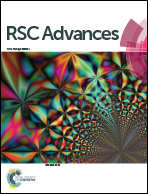Mechanical properties, in vitro degradation behavior, hemocompatibility and cytotoxicity evaluation of Zn–1.2Mg alloy for biodegradable implants
Abstract
Zn, which is a promising alternative candidate as a biodegradable implant material, possesses excellent biocompatibility and biodegradability. However, the insufficiency of its strength and hardness has largely limited its application. Nevertheless, adding alloying elements and mechanical forming by extrusion have generally enhanced its mechanical properties. In the present work, Zn–1.2Mg alloy has been designed and treated by extrusion. Experimental results demonstrated that the studied alloys were composed of a matrix of Zn and a precipitated phase of Mg2Zn11, and the grain size became smaller and more homogeneous after extrusion. The as-extruded alloy exhibited much higher yield strength (YS 219.61 MPa), ultimate tensile strength (UTS 362.64 MPa), elongation (21.31%) and hardness (96.01 HV). The corrosion rates of the as-extruded alloy were higher compared with those of the as-cast alloy and reached values of 0.19 mm per year in electrochemical tests and 0.11 mm per year after exposure in Hank's solution for 30 days, respectively. Moreover, the as-extruded alloy displayed excellent hemocompatibility (hemolysis rate of 1.85%, superior thromboresistance and no signs of thrombogenicity). The viability of human osteosarcoma HOS cells and MG63 cells cultured in diluted extracts of the alloy exceeded 70%, which demonstrated no potential cytotoxicity and tolerance in cellular applications.


 Please wait while we load your content...
Please wait while we load your content...